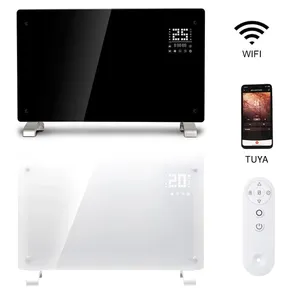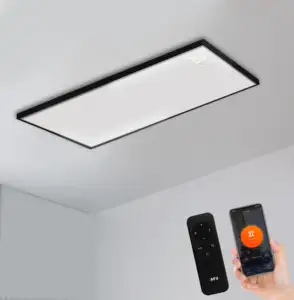

WIFI 2000W Electric Convection Heater Glass Panel Heater Infrared Heating Panel Wall Mounted Convector Heater






















As we continue to seek energy-efficient and cost-effective solutions for our homes, infrared heat panels emerge as a revolutionary option. These innovative devices convert electricity into radiant heat, similar to the warmth of the winter sun, providing a comfortable and highly controllable heating solution. They work by directly transferring heat to objects in the room, ensuring maximum energy efficiency. This article delves into the workings of infrared heat panels, their benefits, and how they can transform your home heating system. We'll also share a case study of a farmhouse transformed into a haven of infrared warmth, and provide a cost and energy efficiency analysis comparing infrared heating to traditional methods.
Infrared heat panels work by converting electricity into radiant heat, a part of the electromagnetic spectrum. This heat is similar to the warmth felt from the winter sun or a coal fire. Infrared heat directly transfers from the heater to the objects in the room, without heating the air in between. This is the same heat we feel from an environment warmed by the sun, and the wavelength most efficiently absorbed by the body. New technology allows us to use infrared radiant heating in a stylish, comfortable, and highly controllable way.
Infrared panel heaters work by transmitting warmth directly to objects and surfaces such as floors and furniture, rather than heating the air. The heat is then transferred indirectly from these heated objects to the air. The principle of infrared heating is that warmth is transferred in waves from the device to colder things and surfaces directly, without loss of heat in empty space. This direct heat transfer path ensures maximum energy efficiency – 100%, without heat loss.
Infrared heat panels offer numerous benefits. They are simple to install, requiring no pipework, and are low maintenance due to the absence of moving parts. They are more efficient than traditional central heating systems, heating objects directly and reducing energy consumption. Infrared panels are aesthetically pleasing, compact, and can be turned into art or mirrors. They can be connected to solar panels for further energy efficiency. Additionally, they can have health benefits, as they don't disturb dust, and produce no noise pollution.
We had the privilege of assisting our client in transforming his entire 1896 farmhouse into a haven of infrared warmth using our high-quality infrared heaters. After a comprehensive remodel, the outcome was impressive. This project showcases how infrared radiant heating panels can revolutionize home heating, turning chilly living spaces into cozy retreats with sun-like warmth. For more details about converting your home to infrared heat, visit our residential heating page.
Installing infrared heat panels is a straightforward process. First, decide where you want to install the heater, with the ceiling being a space-saving option. Next, mount the heater on the wall or ceiling, ensuring it hangs straight. Connect the unit to the socket following the manual instructions. Lastly, if your appliance comes with a thermostat, install it on an inside wall for optimal temperature control. Remember, infrared heaters have insulation at the back, so they don't get too hot.
Infrared panels are versatile and can be placed anywhere on a wall, ceiling, or even on the floor. This flexibility ensures that panels won't be obstructed by furniture, optimizing their heating efficiency. However, it's important to note that in smaller homes, finding unobstructed space for panels can be challenging. For such cases, ceiling panels might be a better option. Also, remember that listed buildings may have limitations on insulation and double glazing upgrades, which could affect the efficacy of infrared heating.
Infrared heating panels are not only efficient but also cost-effective. A 600 Watts infrared panel can heat the same space as a 1500 Watts traditional convection heater, saving about 60% energy. Furthermore, these panels offer the flexibility to heat each room separately, preventing energy wastage. When calculating the power rating, it's crucial to ensure proper heat distribution. On average, an output of 60-150 Watt/m² is suggested, depending on the room size and insulation. Infrared heaters also have an impressive life expectancy of over 30 years, contributing to long-term savings.
Infrared heaters and traditional space heaters differ significantly. Infrared heaters, capable of heating larger areas, utilize the air's humidity, making them more efficient than conventional space heaters. Traditional heaters, like a hair dryer, expel hot, dry air that rises quickly, depleting the air's moisture. In contrast, infrared heat retains moisture, creating a denser heat that fills up an area before rising, thus providing a more comfortable and efficient heating solution.
Infrared heat panels are not only cost-effective but also environmentally friendly. They consume less energy, with consumption rates between 0.29 and 0.8 kW/h, depending on the panel size. This low energy consumption results in a smaller carbon footprint, contributing to less environmental damage. Moreover, these panels are made from 100% recyclable materials like aluminium. By using an app on your smartphone, you can control the energy consumption precisely, leading to more savings. Infrared heaters don't add pollutants into the room during operation, making them an effective, economical, and environmentally friendly heating solution.
Infrared heat panels are a game-changer in home heating solutions. They offer a highly efficient, cost-effective, and environmentally friendly alternative to traditional heating methods. Their ability to directly heat objects, rather than the air, ensures maximum energy efficiency and comfort. They are easy to install, require minimal maintenance, and can be aesthetically integrated into your home decor. Moreover, their low energy consumption and use of recyclable materials contribute to a smaller carbon footprint. With the added benefits of health and noise reduction, infrared heat panels are not just a heating solution, but a step towards a sustainable and comfortable living environment.